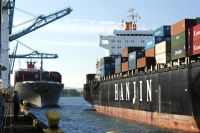forum
library
tutorial
contact

Worth the Wait
by StaffPort Strategy, December 8, 2009
|
the film forum library tutorial contact |

|
Worth the Wait
by StaffPort Strategy, December 8, 2009 |
Portland has historically served a huge hinterland for grain, with 80% of this arriving by rail and 20% by barge
 The last phase of the channel deepening at the Port of Portland is now under way - and it has been a marathon project.
The last phase of the channel deepening at the Port of Portland is now under way - and it has been a marathon project.
As Sam Ruda, marine and industrial development director at Portland, puts it: "One has to have patience. Portland lies 103.5 miles upriver from the mouth of the Columbia and while annual maintenance dredging has been continuing routinely, keeping the channel at 40 ft, the deepening project will provide a depth of 43 ft.
"The project has probably been a 15-year process in the making; there was a lot of environmental litigation involved," he says.
There are many vessels making their way upriver that don't require the additional depth, he says, "but more water is always better" and there will be a clear benefit.
"We have a significant bulk business - grain, minerals - and also container vessels. We are in a fresh water environment, so we don't get the buoyancy of salt water. This deeper channel will improve safety and provide more under-keel clearance."
In preparation for the deeper channel, the port has been steadily deepening its berths in a project that started several years ago. It is now planning to deepen the Terminal 5 bulk terminal, with completion targeted for summer 2010.
Portland, which handled a total of 14.1m tonnes in 2008, has this year seen significant declines in volumes across the cargo sectors. The overall performances are expected to stay similar for the rest of the year, with the exception of continued improvement in grain; Portland has historically served a huge hinterland for grain, with 80% of this arriving by rail and 20% by barge. Last year, Columbia Grain set a new record for its Terminal 5 facility, handling over 4.4m tonnes.
"Based on what we do know, the port is well positioned to weather the storm," says port spokesman Josh Thomas. "There are some signs of life indicating that recovery may be in sight. While the port is starting to build back some business, we're also realistic that recovery will take time and will likely happen gradually."
Meanwhile, Portland is investing heavily in marine terminal and transportation infrastructure. More than $500m worth of construction activity is under way on marine and aviation projects combined, with many projects due for completion in 2010.
Over $50m is going into the port's Rivergate Industrial District, to provide roads, rail and marine terminal upgrades. On the land side, the port continues strategic development of industrial land that has ties to marine cargo. Colgate Palmolive is the first tenant at a 573,420 sq ft warehouse built near the container terminal.
Portland attracted the interest of 59 registered entities and received formal responses from ten when it embarked on a privatisation process for its Terminal 6 container facility.
There was active market interest in a long-term lease of the terminal - but it became clear that market uncertainties would make moving forward very difficult, says Mr Ruda.
"We elected to suspend the process and we continue to evaluate our ongoing approach to the terminal," he says. "But we don't have our backs up against the wall and we don't have any debt."
Portland is probably the last to have port-operated container facilities on the West Coast, he says. "But we don't look at it from the standpoint of 'let's do what everyone is doing'."
The initiative could feasibly be revived at any time, says Portland. "Moving forward, we remain well-positioned to manage the container operation as we have for many years, while remaining open to the prospect of a long-term public-private partnership."
Portland's location on the Columbia Snake River System provides obvious logistics and "green" advantages, linking the port by water to Idaho, Montana, Oregon and Washington.
Next year the US Army Corps of Engineers will undertake some significant upgrades of several locks on the system - a project that has been welcomed by the port.
Meanwhile Portland is committed to its own greenness, says Mr Ruda.
"We believe that by doing the right thing environmentally, we strengthen the port economically - directly or indirectly - through reduced costs and improved efficiencies."
Over the past year the port has purchased renewable energy, fought the spread of invasive species and sent 178 tonnes of food waste to be composted. Vehicle idling has been reduced at all its marine terminals, and the first phase of a major sediment clean-up project has been completed in the Willamette River.
learn more on topics covered in the film
see the video
read the script
learn the songs
discussion forum
